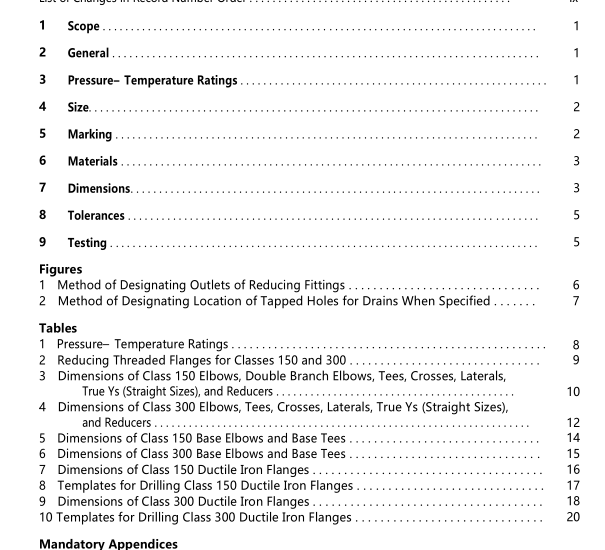ASME B16.42:2016 pdf download Ductile Iron Pipe Flanges and Flanged Fittings Classes 150 and 300
3.2 Ratings of Flanged Joints
Ratings in this Standard apply to flanged joints thatconform to the limitations on bolting in para.6.2 andon gaskets in para.7.8, and which are made up in accor-dance with good practice for alignment and assembly.See also para.3.4.
Use of the ratings for flanged joints not conforming
to these limitations is the sole responsibility of the user.A flanged joint is composed of separate and indepen-
dent, although interrelated, components: the flanges,thegasket, and the bolting, which are assembled by another
influence, the assembler. Proper controls must be exer-cised in the selection and application for all these ele-
ments to attain a joint that has acceptable leak tightness.Special techniques, such as controlled bolt tightening.are described in ASME PCC-1.
If the two flanges in a flanged joint do not have thesame pressure- temperature ratings, the rating of thejoint at any temperature is the lower of the two flangeratings at that temperature.
3.3 Rating Temperature
Temperatures shown for corresponding pressure rat-ing shall be the material temperature of the pressure-
retaining structure. It may be assumed that threeatrerialtemperature is the same as the fluid temperature. Use
of a pressure rating at a material temperature other thanthat of the contained fluid is the responsibility of the
user and subject to the requirements of any applicablecode or regulation.
3.4 Temperature Considerations
Application of the ratings in this Standard to flangedjoints at both high and low temperatures shall take intoconsideration the risk of leakage due to forces andmoments developed in the connected piping or equip-ment. The provisions in paras.3.4.1 and 3.4.2 are
intended to minimize these risks.
3.4.1 Flange Attachment. Threaded flanges are notrecommended for service above 260°C (500°F) if severethermal gradients or thermal cycling is involved.
3.4.2 High-Temperature Service. When used above205°C(400°F), Class 150 flanged joints may develop leak-
age unless care is taken to avoid imposing severe exter-nal loads and/or severe thermal gradients.
3.5 Variances From Ratings
Except as provided herein, ratings are the maximumallowable working pressure for the correspondingtemperature.
3.5.1 Safety or Relief Valve Operation. Under condi-tions of safety valve, relief valve, or rupture disk opera-
tion, the pressure on a flange or flanged fitting may exceed the rated pressure at the pressure-relieving tem-perature by no more than 10%.Such conditions are nec-essarily of short duration.Overpressure greater than theaforementioned under pressure-relieving conditions isthe responsibility of the user, subject to the requirementsof the applicable code or regulation.
3.5.2 Other Variances.Operating variations (tran-sients) that subject a flange or flanged fitting to pressurein excess of the rated pressure at the corresponding
temperature are the responsibility of the user, subject tothe requirements of the applicable code or regulation.
3.5.3 System Hydrostatic Test. Flanged joints andflanged fittings may be subjected to system hydrostatictests at a pressure not to exceed the hydrostatic shelltest pressure specified in para.9.3.Testing at any higherpressure is the responsibiity of the user.
4 SIZE
4.1 Nominal size
As applied in this Standard, the use of the phrase”nominal pipe size” or the designation NPS followedby a dimensionless number is for identifying the endconnection of piping, flanges, or flanged fittings.Thenumber is not necessarily the same as the inside diame-ter of the flange or flanged fitting.The diameter of abolt is its nominal size. Use of nominal indicates thatthe stated size or dimension is only for designation, notmeasurement.
4.2 Reducing Fitting sizes
Reducing fittings shall be designated by the size ofthe openings in their proper sequence as indicated inthe sketches. See Fig.1.
4.3 Reducing Flange Sizes
Reducing flanges shall be designated by the two nomi-nal pipe sizes.See examples in Note (4) of Table 2.
5 MARKING
Except as modified herein, flanges and flanged fittingsshall be marked as required in Mss sP-25.
(a)Name.The manufacturer ‘s name or trademarkshall be applied.
(b) Material.The word “DUCTILE,” or “Dr” wherespace does not permit “DUCTILE,” shall be applied.(c) Rating Class. Numerals shall be applied giving thepressure rating class for which the product is designed.(d) Designation. The designation“B16″ shall be
applied, preferably located adjacent to the Class designa-tion, to indicate conformance to this Standard.
(e)Temperature. No temperature markings are
required on flanges and flanged fittings, but if marked,
